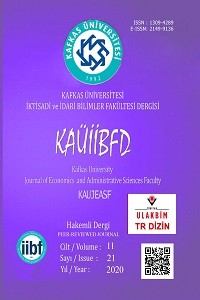EĞİTİM KURUMLARINDA YÖNETİCİLERİN KULLANDIKLARI LİDER-GÜÇ KAYNAKLARININ ÖRGÜTSEL ÖĞRENME ÜZERİNDEKİ ETKİ VE SONUÇLARI
Abstract
Bu çalışma, ilkokullarda görevli yöneticiler tarafından kullanılan güç kaynaklarının örgütsel öğrenme üzerindeki etkilerini konu almaktadır. Çalışma kapsamında Denizli ilinde yer alan ilkokullarda çalışan 217 öğretmenden anket yolu ile veri elde edilmiştir. Değişkenler arasındaki ilişkileri incelemek amacıyla ANOVA, t-testi, korelasyon analizi ve regresyon analizi gerçekleştirilmiştir. Yapılan analizler neticesinde lider güç kaynakları boyutlarından karizmatik güç (β=0,15, p<0,05), uzmanlık gücü (β=0,34, p<0,01) ve zorlayıcı gücün (β=0,09, p<0,05) örgütsel öğrenme üzerinde anlamlı etkilere sahip olduğu gözlenmiştir. Buna karşın; diğer güç kaynakları ile birlikte ele alındığında ödüllendirici güç ve yasal gücün örgütsel öğrenme üzerinde beklenilen etkiyi göstermediği tespit edilmiştir. İlkokul yöneticilerinin sahip oldukları deneyim ve bilgi birikiminden kaynaklanan uzmanlık güçlerinin, örgütsel öğrenme sürecinde kullanabilecekleri en önemli güç türü olduğunun anlaşılması bu çalışmanın temel çıktısını oluşturmaktadır.
Keywords
References
- Baker, W. E., & Sinkula, J. M. (1999). The Synergistic Effect of Market Orientation and Learning Orientation on Organizational Performance. Journal of the Academy of Marketing Science, 27(4), 411-427. doi:10.1177/0092070399274002
- Dai, Z., Duserick, F., & Dai, L. (2005). Achieving competitiveness by organizational learning: Strategy, transformation and measurement. Issues in Information Systems, 6(2), 147-153.
- Daft, R. L., & Steers, R. M. (1986). Organizations: A Micro/Macro Approach. Glenview, IL: Scott Foresman.
- Dodgson, M. (1993). Organizational learning: A review of some literatures. Organization Studies, 14(3), 375-394. doi:10.1177/017084069301400303
- French, J. R. P., & Raven, B. (1959). The Bases of Social Power. In D. Cartwright & A. Zander (Eds.), Studies in Social Power (pp. 150-167). Ann Arbor, MI: University of Michigan Press.
- Fullan, M. (1995). The school as a learning organization: Distant dreams. Theory Into Practice, 34(4), 230-235. doi:10.1080/00405849509543685
- Garvin, D. A. (1993). Building a learning organization. Harvard Business Review, July-August, 78-91.
- George, J. M., & Jones, G. R. (1995). Understanding and Managing Organizational Behavior. Reading: Addison-Wesley.
- Huber, G. P. (1991). Organizational learning: The contributing processes and the literatures. Organization Science, 2(1), 88-115. doi:10.1287/orsc.2.1.88
- Klimecki, R., & Lassleben, H. (1999, June). What causes organizations to learn? In M. Easterby-Smith, L. Araujo, & J. Burgoyne (Eds.), Organizational Learning (Proceedings of the 3rd International Conference on Organizational Learning) (pp. 557-578). Lancaster, UK.
- Kofman, F., & Senge, P. M. (1993). Communities of commitment: The heart of learning organizations. Organizational Dynamics, 22(2), 5-23. doi:10.1016/0090-2616(93)90050-b
- Marsick, V. J., & Watkins, K. E. (2003). Demonstrating the value of an organization's learning culture: The dimensions of the learning organization questionnaire. Advances in Developing Human Resources, 5(2), 132-151. doi: 10.1177/1523422303005002002
- Miles, R. E., Snow, C. C., Meyer, A. D., & Coleman, H. J. (1978). Organizational strategy, structure, and process. The Academy of Management Review, 3(3), 546-562. doi:10.2307/257544
- Pfeffer, J. (1992). Understanding power in organizations. California Management Review, 34(2), 29-50. doi:10.2307/41166692
- Popper, M. (1998). Organizational Learning Mechanisms: A Structural and Cultural Approach to Organizational Learning. The Journal of Applied Behavioral Science, 34(2), 161-179. doi:10.1177/0021886398342003
- Rahim, M. A. (1989). Relationships of leader power to compliance and satisfaction with supervision: Evidence from a national sample of managers. Journal of Management, 15(4), 545-556. doi:10.1177/014920638901500404
- Rahim, M. A., Antonioni, D., & Psenicka, C. (2001). A structural equations model of leader power, subordınates' styles of handling conflict, and job performance. International Journal of Conflict Management, 12(3), 191-211. doi:10.1108/eb022855
- Salancik, G. R., & Pfeffer, J. (1977). Who gets power and how they hold on to it: A strategic-contingency model of power. Organizational Dynamics, 5(3), 3-21. doi:10.1016/0090-2616(77)90028-6
- Schechter, C. (2007). Organizational learning mechanisms: The meaning, measure, and implications for school improvement. Educational Administration Quarterly, 44(2), 155-186. doi:10.1177/0013161x07312189
- Schechter, C., Sykes, I., & Rosenfeld, J. (2008). Learning from success as leverage for school learning: lessons from a national programme in Israel. International Journal of Leadership in Education, 11(3), 301-318. doi:10.1080/13603120701576274
- Senge, P. (1990). The Fifth Discipline: The Art and Practice of The Learning Organization. New York: Doubleday.
- Silins, H. C., Mulford, W. R., & Zarins, S. (2002). Organizational learning and school change. Educational Administration Quarterly, 38(5), 613-642. doi:10.1177/0013161x02239641
- Stoner, J. A. F., & Freeman, E. R. (1995). Management. Englewood Cliffs, New Jersey: Prentice-Hall.
- Ward, E. W. (1998). Managerial power bases and subordinates’ manifest needs as influences on psychological climate. Journal of Business and Psychology, 12(3), 361-378.
- Yagil, D. (2002). Substitution of a leader’s power bases by contextual variables. International Journal of Organization Theory and Behavior, 5(3-4), 383-399.
- Yukl, G. (1989). Managerial leadership: A review of theory and research. Journal of Management, 15(2), 251-289. doi:10.1177/014920638901500207
- Yukl, G., & Falbe, C. M. (1991). Importance of different power sources in downward and lateral relations. Journal of Applied Psychology, 76(3), 416-423. doi:10.1037/0021-9010.76.3.416
Details
| Primary Language | Turkish |
|---|---|
| Journal Section | Articles |
| Authors | |
| Publication Date | June 30, 2020 |
| Acceptance Date | February 25, 2020 |
| Published in Issue | Year 2020 Volume: 11 Issue: 21 |
Cited By
Okul Müdürlerinin Öğretimsel Liderlik Davranışları ile Öğretmenlerin Öğrenen Örgüt Algıları Arasındaki İlişkinin İncelenmesi
Gazi Üniversitesi Gazi Eğitim Fakültesi Dergisi
https://doi.org/10.17152/gefad.1078572
KAUJEASF is the corporate journal of Kafkas University, Faculty of Economics and Administrative Sciences Journal Publishing.
KAUJEASF has been included in Web of Science since 2022 and started to be indexed in the Emerging Sources Citation Index (ESCI ), a Clarivate product.

